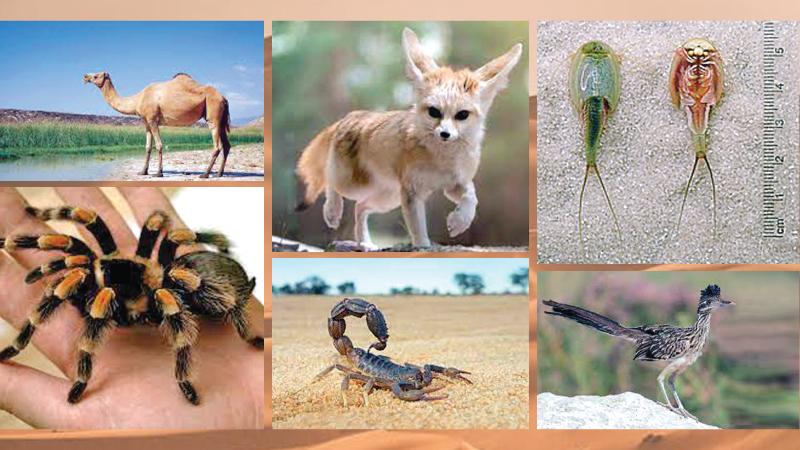
Deserts are some of the harshest environments on Earth. They are hot, dry, and often barren. But even in these harsh conditions, a variety of animals have found ways to survive. This article, features some of the most interesting and unique desert animals. Discover how they have adapted to life in the desert and their fascinating behaviour.
– Dinara Thuljan Hettiarachchi
Garde 10, Ananda College, Colombo.
****

Dromedary camels
Dromedary camels are large, hump-backed mammals which are native to the deserts of Africa and Asia. They are well-adapted to life in the desert with thick fur to keep them warm at night and large flat feet to help them walk on sand.
Dromedaries are herbivores and eat a variety of plants, including grass, shrubs and leaves. Dromedaries can eat thorny plants and dry leaves, which makes them well-suited for life in the desert. They can travel long distances to find food and water. These animals are used by people for transportation, milk production, and wool production.
****

Scorpions
Scorpions are arachnids which are found in deserts all over the world. They have a venomous sting that can be deadly to humans.
Scorpions are related to spiders. They are characterised by their segmented bodies and pincers. Scorpions are predators and their diet consists of insects, spiders, and other small animals. They use their pincers to capture prey and their stinger to inject venom
****

Fennec foxes
Fennec foxes (Vulpes zerda) are small, desert-dwelling foxes which are native to North Africa. They have large ears that help them to dissipate heat and to listen for prey. It is the smallest fox species in the world.
They have long, thick fur that helps them to stay warm at night. Fennec foxes are nocturnal animals and are most active at night. They are very good at digging and use their claws to dig burrows in the sand. Fennec foxes are omnivores and eat a variety of including insects, small mammals, birds, eggs, and fruit.
****

Tarantulas
Tarantulas are large spiders which are found in deserts and other arid regions. They are not venomous, but their bite can be painful.
Tarantulas are not aggressive spiders and will only bite if they feel threatened. They vary in size from a few inches to over a foot in length. Tarantulas are an important part of the ecosystem and help to control populations of insects.
****

Tadpole shrimps
Tadpole shrimps are small crustaceans which live in temporary pools in deserts. They can survive for long periods of time in dry conditions by burrowing into the sand. They are sometimes called ‘fairy shrimp’ because of their delicate appearance. They are not actually shrimp but are more closely related to insects
Tadpole shrimps are about 2-5 centimetres long and have a broad, flat carapace that protects their head and gills. Tadpole shrimps are omnivores and eat a variety of small aquatic organisms, including algae, insects, and other crustaceans.
****

Roadrunner
The roadrunner is a large, ground-dwelling bird that is native to the deserts of the southwestern United States and Mexico. It is known for its speed and its ability to run across the desert floor.
Roadrunners are about two feet long and have long, slender legs and a long tail. They are brown and white in colour, with a black crest on their head. Roadrunners are omnivores and eat a variety of food, including even scorpions.
These are just a few of the many interesting and unique desert animals. These creatures have adapted to life in the desert in amazing ways. They are a testament to the resilience of life, even in the harshest of environments.
